New York-based American architect and watercolorist, Steven Holl is among the famous and influential architects of the contemporary era, thanks to the projects carried out mainly in New York and in the East (China, Japan, South Korea).
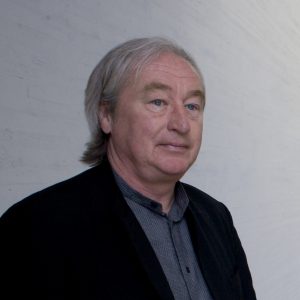
Image source: https://en.wikipedia.org/wiki/Steven_Holl#/media/File:Steven_Holl.jpg
What Do We Know About The Author?
Steven Holl was born in Bremerton, Washington, in 1947. After attending the University of Washington (Bachelor of Arts) in 1971, Holl continued his architectural studies in Rome and London. On returning to the United States, in 1976, he established Steven Holl Architects in NYC, where he also served on the faculty of Columbia University from 1981. He has held courses at various other institutions, including the University of Washington in Seattle, the Pratt Institute in New York, and the University of Pennsylvania. His works have been exhibited, among other things, at the Museum of Modern Art and the Walker Art Center of Minneapolis. In 1993, Steven Holl Architects won the first prize in the competition for the construction of the Contemporary Art Museum in Helsinki which was inaugurated in May 1998.

Image source: https://en.wikipedia.org/wiki/Linked_Hybrid
Among his works there are large buildings in many cities around the world, like Nanjing Sifang Art Museum in Nanjing, China, an addition to and renovation of the Amerika-Gedenkbibliothek (American Memorial Library) in Berlin. His later work concentrated on urban-scale mixed residential and commercial projects in China. In 2000, he became a member of the American Academy of Arts and Letters. Among his many honours are the Alvar Aalto Medal (1998), the Cooper Hewitt National Design Award for architecture (2002), the American Institute of Architects Gold Medal (2012), and the Japan Art Association’s Praemium Imperiale prize for architecture (2014).
Info source: https://www.britannica.com/biography/Steven-Holl
Which Are Holl’s Most Important Works?
- Visual Arts Building
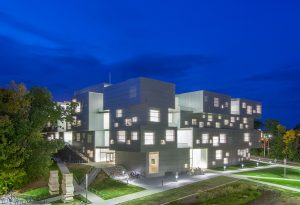
Steven Holl does not shy away from the firm’s signature style in the Visual Arts Building at the University of Iowa. The building, designed in collaboration with sustainability specialist BNIM, comprises spaces for interdisciplinary learning of the visual arts, as well as galleries, faculty offices, teaching facilities and an outdoor rooftop studio. Steven Holl Architects’ new design adds to the university’s “arts quad” alongside the 2006 School of Art and Art History, also designed by the firm. The construction is open and connected both physically and metaphorically. “The aim of maximum interaction between all departments of the school takes shape in social circulation spaces” explains the firm. “Interdisciplinary collaboration is facilitated by the vertical carving out of large open floor plates, so that students can see activities ongoing across these openings and are encouraged to interact and meet.” Interconnection is also achieved through glass partitions along the studio walls and, of the course, the visual link with the existing School of Art and Art History.
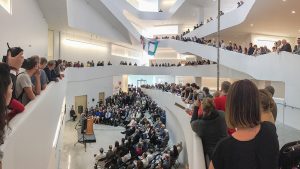
Image source: https://en.wikipedia.org/wiki/University_of_Iowa_School_of_Art_and_Art_History#/media/File:VAB_dedication.jpg
he firm describes how the cuts through the structure also provide the “centres of light” that are so important to the overall interior atmosphere. “The seven vertical cut-outs are characterized by a language of shifted layers, where one floor plate slides past another.” Natural light and ventilation reach into the core of the building through this method, the result of which gives an underlying appearance of a building that has been discreetly opened up to examine different perspectives of the space. The project is somewhat reminiscent of Holl’s 2004 design for the NYU Department of Philosophy, which also focuses on channelling light into the building. In fact, it is a signature style of the firm to cut holes in the exterior fabric in order to direct natural light into the circulation spaces of the interior. Naturally, this illuminates the studio spaces, giving a proficient setting for artistic activities and study.
Info source: https://www.frameweb.com/news/steven-holl-architects-punctuates-volumes-to-form-centres-of-light
- The Institute for Contemporary Arts
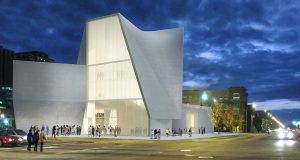
Image source: https://www.inexhibit.com/it/mymuseum/institute-contemporary-art-richmond-virginia-steven-holl-architects/ by VCU Libraries
After almost seven years of processing and $41 million invested, the new Institute for Contemporary Arts by Steven Holl Architects, was recently inaugurated. The origins of the ICA date back to 1931, when the VCU Art School opened the Anderson Gallery, the first public art gallery in Richmond. When in 2012, the institution announced the construction of a new exhibition site, the task was given to Holl. Located on the edge of the Virginia Commonwealth University (VCU) campus in Richmond, the new exhibition center for contemporary art stands as a liaison between the university and the surrounding community, showing itself as a great gateway over the most busy in the US city. “The building” – said Steven Holl referring to the project – “is an experience of movement over time, both inside and outside. Approaching on foot from the west the museum develops in a vortex of changing perspectives, arriving instead by car from the north, east or south, the double vertical torsion geometry marks a landmark, which changes shape.”
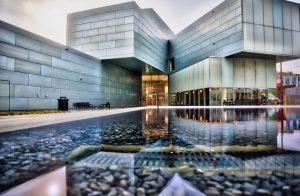
Image source: https://search.creativecommons.org/photos/fcfe881a-dff2-4589-9391-d6a196018bc0 by Sky Noir
The whole complex consists of seven volumes arranged “radially” and internally divided into three levels: Holl conceived this form inspired by the concept of “bifurcated time“ which “suggests that many parallel times coexist in the contemporary art world” (Steven Holl). The choice of coating materials, together with the fluid volume arrangement and the slight torsion of the tower, enhances the changing and dynamic presence of the building. The external opaque translucent glass changes its perception from monolithic to multi-purpose translucent opaque, depending on the light. At night, the darkened light glass panels activate the external cladding, transforming the volumes into a lantern, on which video projections can be played, which animate the exterior with art, meetings and public programs. The architecture of the ICA is not only a tool for exhibitions but it is also an example of a sustainable building in the LEED Gold category, heated and cooled thanks to geothermal wells.
“We desire an architecture that is integral rather than empirical, that has depth rather than breadth. We desire an architecture that will inspire the soul.”
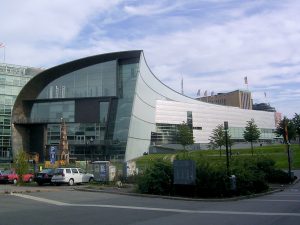
Image source: https://en.wikipedia.org/wiki/Steven_Holl#/media/File:Helsinki_Kiasma.jpg
Steven Holl is an American architect and artist whose built works draw on contemporary theories of Phenomenology. Instead of imposing a style on a site, he argued, the site itself should generate the “architectural idea” applied to it. In November 2016, Steven Holl received The Daylight Award for Daylight in Architecture. Holl’s ability to orchestrate rooms with light is unparalleled; the emotional intensity of his rooms and buildings is impressive. Their special quality arises from his method of working; he deliberately keeps his office small, prefers to draft his initial designs using a watercolor pad and gets his inspirations from music, philosophy and literature. The quality of Holl’s architecture cannot be expressed in terms of numbers but is immediately accessible to the senses. Rather than impressing the viewer with an eye-catching design, his buildings stimulate those who wander through them with their atmospheric density and complexity. He uses one medium in particular to inspire the soul: daylight.
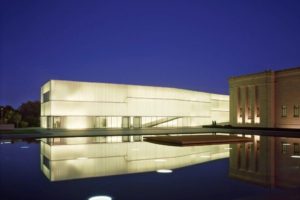
Image source: https://en.wikipedia.org/wiki/Steven_Holl#/media/File:Nelson-night-lens.jpg
Space is oblivion without light; this sentence is, in many ways, the complementary counterpart of Louis Kahn’s famous verdict, “the sun never knew how great it was until it hit the side of a building.” Daylight and architecture need one another; only in their interaction can they be truly experienced by humans. Steven Holl refers to Louis Kahn as one of the architects who had an early influence on his own work with daylight. Steven Holl said that “we tend to underestimate the psychological power and the health aspects of light, particularly in our society, which is often driven more towards commercial ends. As architects, it is our task to bring these aspects to the table, and to remind our clients and all the experts involved in building design today of the psychological and biological importance of light.” In all his designs, Steven Holl takes up the challenge of bringing daylight into places where it is not usually found. “In my buildings, I take great care that all rooms receive natural light. Whether it is a bedroom in a hospital, a meeting room in an office or a museum gallery, daylight is important for all these spaces. Even inside a building, you need to be able to feel the passing of the day and to see the sun setting.”
